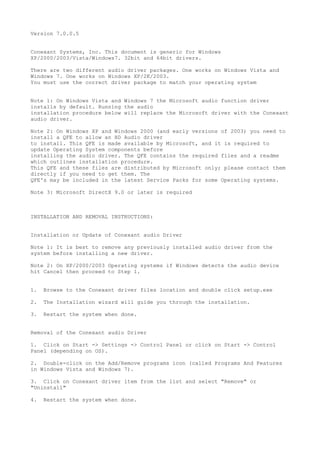Readme
- 1. Version 7.0.0.5 Conexant Systems, Inc. This document is generic for Windows XP/2000/2003/Vista/Windows7. 32bit and 64bit drivers. There are two different audio driver packages. One works on Windows Vista and Windows 7. One works on Windows XP/2K/2003. You must use the correct driver package to match your operating system Note 1: On Windows Vista and Windows 7 the Microsoft audio function driver installs by default. Running the audio installation procedure below will replace the Microsoft driver with the Conexant audio driver. Note 2: On Windows XP and Windows 2000 (and early versions of 2003) you need to install a QFE to allow an HD Audio driver to install. This QFE is made available by Microsoft, and it is required to update Operating System components before installing the audio driver. The QFE contains the required files and a readme which outlines installation procedure. This QFE and these files are distributed by Microsoft only; please contact them directly if you need to get them. The QFE's may be included in the latest Service Packs for some Operating systems. Note 3: Microsoft DirectX 9.0 or later is required INSTALLATION AND REMOVAL INSTRUCTIONS: Installation or Update of Conexant audio Driver Note 1: It is best to remove any previously installed audio driver from the system before installing a new driver. Note 2: On XP/2000/2003 Operating systems if Windows detects the audio device hit Cancel then proceed to Step 1. 1. Browse to the Conexant driver files location and double click setup.exe 2. The Installation wizard will guide you through the installation. 3. Restart the system when done. Removal of the Conexant audio Driver 1. Click on Start -> Settings -> Control Panel or click on Start -> Control Panel (depending on OS). 2. Double-click on the Add/Remove programs icon (called Programs And Features in Windows Vista and Windows 7). 3. Click on Conexant driver item from the list and select "Remove" or "Uninstall" 4. Restart the system when done.
- 2. Running an Unattended (Silent) Installation 1. From the task bar, click on Start -> Run 2. In the Run dialog box, type X:pathsetup -s (where X is the path to the audio driver files) 3. Restart the system when done. Running an Unattended (Silent) Uninstallation 1. From the task bar, click on Start -> Run 2. In the Run dialog box, type X:pathsetup -s REMOVE (where X is the path to the audio driver files) 3. Restart the system when done. * This driver is built for the Microsoft(R) Windows Operating Systems. Copyright 2009 Conexant Systems, Inc. All rights reserved. *


